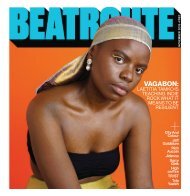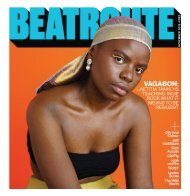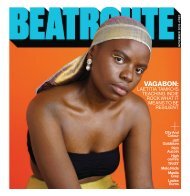BeatRoute Magazine B.C. print e-edition - April 2016
BeatRoute Magazine is a monthly arts and entertainment paper based in Western Canada with a predominant focus on music – local, independent or otherwise.
BeatRoute Magazine is a monthly arts and entertainment paper based in Western Canada with a predominant focus on music – local, independent or otherwise.
Create successful ePaper yourself
Turn your PDF publications into a flip-book with our unique Google optimized e-Paper software.
THE ARCS<br />
finding chemistry within the studio<br />
by Jennie Orton<br />
photo: Alysse Gafkjen<br />
Dan Auerbach is moving forward with his new band The Arcs.<br />
always said they put notes on<br />
paper, but that’s not music. What do<br />
“I’ve<br />
you do with the notes? What do you<br />
do with the charts? What do you do with<br />
the chords? It’s what you put into it.” That<br />
was legendary guitar player and session<br />
musician Tommy Tedesco describing the<br />
art of studio session playing.<br />
Singer and guitarist Dan Auerbach<br />
knows that to be true. The collaborative<br />
and improvisational precision that has<br />
created the nearly five albums of material<br />
with his new project The Arcs in the last<br />
year is the result of that studio musician<br />
skill and humble creative camaraderie<br />
that has built so much of the hit music of<br />
the last five decades.<br />
“If you’ve got a good heart and an<br />
open mind, I think it goes really far in<br />
the studio. Because the best music in<br />
man’s history is all done by collaboration.<br />
Always,” says Auerbach. “Interpretation<br />
by different musicians and combinations<br />
is what makes music so special.”<br />
The musicians that make up The<br />
Arcs are a roster of studio greats with<br />
rap sheets a mile long and skill to spare.<br />
Auerbach sits on vocals and guitar and is<br />
joined by Truth and Soul Records founder<br />
Leon Michels, Black Keys touring bassist<br />
Richard Swift, Menahan Street Band<br />
drummer Homer Steinweiss, frequent<br />
Amy Winehouse and Mark Ronson<br />
collaborator Nick Movshon, and guitarist<br />
Kenny Vaughan.<br />
“It’s really fun. I’ve never played with a<br />
group of guys like this,” he says. “I mean I am<br />
a decent musician but these guys are pretty<br />
amazing. Phenoms all of them, really.”<br />
The result is an affectionate freeform<br />
jam session of a catalogue that marries very<br />
diverse and well cultivated influences with<br />
impeccably practiced style to create an<br />
effortless psychedelic soul funk rock hybrid<br />
with swagger, teeth, and history to spare.<br />
“We get together, we start fiddling with<br />
our instruments and ten minutes later<br />
we have that recorded,” recalls Auerbach.<br />
“That’s kind of how it works, and it sounds<br />
a little crazy but we’re all in a point in our<br />
lives where we are clicking on all cylinders.”<br />
The rare breed that is the studio<br />
session musician has been a common and<br />
indelible thread in music since recordings<br />
were first pressed. The skill levels required<br />
to sight read and play music within<br />
hours of getting eyes on it, playing other<br />
people’s visions for the love of playing,<br />
and the sake of making a paycheque,<br />
allows for a unique acquisition of a skill<br />
sets most musicians couldn’t fathom. This<br />
explains not only The Arcs’ large amount<br />
of output in the last 12 months but also<br />
the resume of influences on their first<br />
album Yours, Dreamily.<br />
You can hear the time spent by Nick<br />
Movshon and Homer Steinweiss with<br />
The Dap Kings on “Put a Flower in your<br />
Pocket,” and Amy Winehouse’s ghost is all<br />
over “Pistol Made of Bones.” The presence<br />
of every bit of modern soul and rock is<br />
in “Stay in My Corner” ( which is also the<br />
only song all musicians were available to<br />
record together at once). These guys have<br />
brought their resume to this gig and have<br />
created a fun feast of what they do best,<br />
but for themselves for once.<br />
“I finally got to make an album with<br />
these guys that was ours. In some form, this<br />
group has made dozens of records together<br />
over the years but they were never our<br />
records,” muses Auerbach.<br />
“We would make Lana Del Ray records,<br />
or Dr. John records, or whoever we had in<br />
the studio. So it was just that idea of having<br />
ownership of something. It seemed to<br />
bring the best out.”<br />
Tedesco was famous for saying, “there<br />
are four reasons to take a gig: for the money,<br />
for the connections, for the experience,<br />
or for the fun.” It would appear The Arcs<br />
exist for at least three of those.<br />
“We’re just all gonna keep making music<br />
together until it’s not fun,” says Auerbach.<br />
“I only do it because I love it, I would never<br />
do it for any other reason. I feel very lucky.”<br />
The Arcs performs at the Commodore Ballroom<br />
on <strong>April</strong> 11<br />
WILD NOTHING<br />
solo project becomes a full band effort<br />
For the most part, Wild Nothing has been a<br />
one-man show, with guests brought in to<br />
make touring possible, but Jack Tatum is<br />
becoming more willing to allow other musicians<br />
to participate in the creation of his sonic vision.<br />
Beatroute got a chance to speak with Tatum at<br />
his home in Los Angeles, and he talked a bit about<br />
the beginnings of Wild Nothing.<br />
“The first record I did, Gemini, was made just by<br />
me, writing and recording all of the parts and putting<br />
it all together myself.” This was in 2009, when<br />
Tatum was still a student at Virginia Tech University<br />
in the small city of Blacksburg. “I’d written<br />
tons of songs before that, but that was the first<br />
time I’d tried to challenge myself to make a [full]<br />
record.” His insular approach to songwriting has<br />
persisted: “Part of that has to do with [the need<br />
for] me having a monopoly on my own ideas, and<br />
not being able to easily compromise. I’m definitely<br />
kind of controlling when I hear something in my<br />
head, and I need it to be a certain way, otherwise<br />
I feel frustrated.” But, he says, he’s become more<br />
open to including other people in the process of<br />
recording, as evidenced by the participation of<br />
drummer John Ericsson (of Peter, Bjorn, and John),<br />
guitarist Brad Laner (of Medicine), and others on<br />
his most recent record.<br />
“It’s these small little battles, allowing people to<br />
come in and do stuff on top of what you’ve written,<br />
and seeing how that plays out. I want to keep doing<br />
more of that sort of thing…it would be difficult<br />
to make the kind of records I make now without<br />
getting other opinions, and other players involved.”<br />
Wild Nothing’s third album, Life of Pause, was<br />
released in February, almost a full four years after<br />
the previous album’s release in 2012. “Life just kind<br />
of catches up with you,” Tatum says. “I was working<br />
on this record, but not constantly…before I<br />
knew it three or four years had gone by.” It will be<br />
clear to fans of Wild Nothing’s previous releases<br />
that Life of Pause represents a different direction<br />
for the band, substituting the atmospheric,<br />
dreamy pop sensibilities of 2012’s Nocturne with<br />
more brusque indie rock ambience.<br />
On the subject of taking musical risks, Tatum<br />
cites David Byrne as an inspiration: “It’s hugely<br />
inspiring, because he’s constantly got some new<br />
project he’s working on it seems…he’s not a onetrack<br />
mind guy.” Although he is clearly motivated<br />
by a desire to explore new musical avenues, Tatum<br />
can relate to the expectations of consistency<br />
from fans: “You get used to something, and you<br />
can have really deep emotional relationships with<br />
the music that you love, and you can feel a real<br />
betrayal when someone shifts from what you’ve<br />
come to know them for…but, it’s different as a<br />
musician, like, I’m usually rooting for people when<br />
they try and do something different, even if it<br />
doesn’t pan out. I think it’s better to try.”<br />
Not only is Life of Pause a foray into a different<br />
sound, it also takes a unique approach to the idea<br />
of an album as an artifact. The cover art for the<br />
record is a photograph of Tatum sitting in a chic<br />
1970s-style living room, built specifically for the<br />
purpose of being used for this album. Accompanying<br />
the release of the album, Wild Nothing also<br />
released a music video that encompasses two<br />
songs and features the same room as the backdrop<br />
in a kind of cinematic album art. “Every record<br />
that I’ve done is an attempt to make a small<br />
little world within itself,” Tatum says. “I’ve always<br />
enjoyed the idea that a record can be something<br />
Wild Nothing’s Jack Tatum is learning to let people into his musical world.<br />
by Galen Robinson-Exo<br />
that you step in and out of, that has an identity of<br />
its own, and it was no different with this record.<br />
We just took it a little further and made it a bit<br />
more literal by envisioning this physical space for<br />
the record to live in. It was important to me that<br />
people feel like there was a sort of physicality to<br />
the record.” What worlds will continue to emerge<br />
from Wild Nothing’s ever-changing trajectory? We<br />
look forward to finding out.<br />
Wild Nothing performs at the Biltmore Cabaret on<br />
<strong>April</strong> 26<br />
10 APRIL <strong>2016</strong> •<br />
Music


















